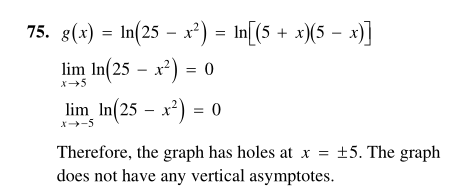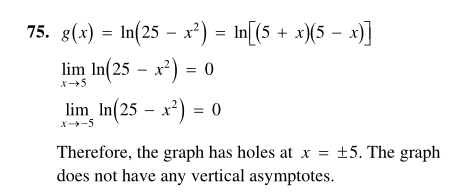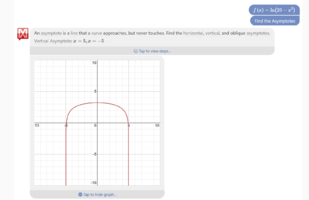You are using an out of date browser. It may not display this or other websites correctly.
You should upgrade or use an alternative browser.
You should upgrade or use an alternative browser.
Does this function have vertical asymptotes? [ln(25-x^2]
- Thread starter Integrate
- Start date
Dr.Peterson
Elite Member
- Joined
- Nov 12, 2017
- Messages
- 16,871
Clearly they are wrong. That happens.By my understanding this function very much has vertical asymptotes as ln can never equal zero.
So why does the solution manual say this function doesn't have vertical asymptote.
View attachment 34729
View attachment 34730
The two limits are [imath]-\infty[/imath], not 0. (And they are one-sided limits.)
I don't know what they were thinking; those certainly are not holes!
AvgStudent
Full Member
- Joined
- Jan 1, 2022
- Messages
- 256
From my understanding, holes are the removable discontinuity of the function.By my understanding this function very much has vertical asymptotes as ln can never equal zero.
So why does the solution manual say this function doesn't have vertical asymptote.
View attachment 34729
View attachment 34730
For example,
[math]\dfrac{(2x-3)(x+1)(x-2)}{(x+2)(x+1)}[/math]
Since the numerator and denominator contain (x+1), we can cancel them out so we have a hole at (-1,15).
On the other hand, x=-2 is a vertical asymptote.
I think you're correct to call those vertical asymptotes instead of holes.
Steven G
Elite Member
- Joined
- Dec 30, 2014
- Messages
- 14,603
If you think that those limits equal 0, then what is the problem? 0 is a well defined value. The graphs (based on you thinking that the limits are 0) should NOT have a hole in it. The y-value, when x= +/- 5, is 0.By my understanding this function very much has vertical asymptotes as ln can never equal zero.
So why does the solution manual say this function doesn't have vertical asymptote.
View attachment 34729
Of course, as Dr Peterson pointed out, those limits do not equal 0.
jonah2.0
Full Member
- Joined
- Apr 29, 2014
- Messages
- 622
From what calculus textbook is that from?By my understanding this function very much has vertical asymptotes as ln can never equal zero.
So why does the solution manual say this function doesn't have vertical asymptote.
View attachment 34729
View attachment 34730
Integrate
Junior Member
- Joined
- May 17, 2018
- Messages
- 129
LarsonFrom what calculus textbook is that from?
Integrate
Junior Member
- Joined
- May 17, 2018
- Messages
- 129
Feels good to find errors. Like really good.Clearly they are wrong. That happens.
The two limits are [imath]-\infty[/imath], not 0. (And they are one-sided limits.)
I don't know what they were thinking; those certainly are not holes!
jonah2.0
Full Member
- Joined
- Apr 29, 2014
- Messages
- 622
Beer induced ramblings follow.

Fortunately, the section for the Answers to All Odd-Numbered Exercises and Tests at the back of the book gives the correct answer (Review Exercise #75)

By my understanding this function very much has vertical asymptotes as ln can never equal zero.
So why does the solution manual say this function doesn't have vertical asymptote.

Fortunately, the section for the Answers to All Odd-Numbered Exercises and Tests at the back of the book gives the correct answer (Review Exercise #75)



